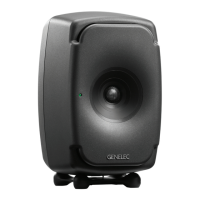6
Figure 8. The curves above show the horizontal directivity
characteristics of the 8331A.
Figure 9. The curves above show the vertical directivity
characteristics of the 8331A.
Figure 6. The curves above show the effect of the “Bass Tilt”,
“Treble Tilt”, “Desktop Low Frequency” and “Bass Roll-Off” controls
on the free field response of the 8331A.
Figure 7. Frequency responses at 0, 15, 30, 45 and 60 degree
angles and power response in full space. Input level -20 dBu.
• Note that the amplifier is not completely disconnected
from the AC mains service unless the mains power cord is
removed from the monitor loudspeaker or the mains outlet.
• Free flow of air behind and around the monitor is
necessary to maintain sufficient cooling. Do not obstruct
airflow around the monitor.
WARNING!
The 8331A is capable of producing sound pressure levels in
excess of 85 dB, which may cause hearing damage. Sound
exposure level integrated over an 8 hour working day should
be limited to 80 dB(A) to reduce the risk of permanent hearing
damage. For each 3 dB increase in sound exposure, half the
exposure time should be observed (equal energy).
Guarantee
The Genelec 8331A is guaranteed for two years against
manufacturing faults or defects altering performance. Refer to
the reseller for full sales and guarantee terms.
Compliance To FCC Rules
Note: This equipment has been tested and found to comply
with the limits for a Class B digital device, pursuant to part
15 of the FCC Rules. These limits are designed to provide
reasonable protection against harmful interference in a
residential installation. This equipment generates, uses and
can radiate radio frequency energy and, if not installed and
used in accordance with the instructions, may cause harmful
interference to radio communications. However, there is
no guarantee that interference will not occur in a particular
installation. If this equipment does cause harmful interference
to radio or television reception, which can be determined by
turning the equipment off and on, the user is encouraged to
try to correct the interference by one or more of the following
measures:
• Reorient or relocate the receiving antenna.
• Increase the separation between the equipment and
receiver.
• Connect the equipment into an outlet on a circuit
different from that to which the receiver is connected.
• Consult the dealer or an experienced radio/TV technician
for help.
Modifications not expressly approved by the manufacturer
could void the user’s authority to operate the equipment under
FCC rules.
20
20k
50
100
200
500
1k 2k
5k
10k
Frequency Hz

